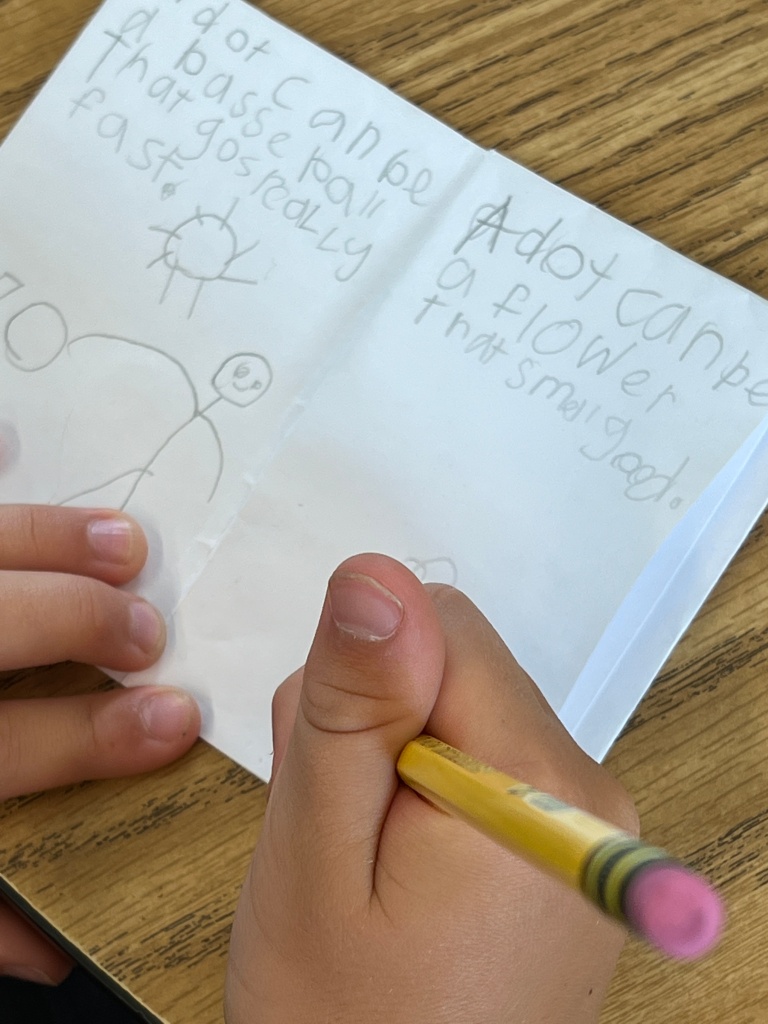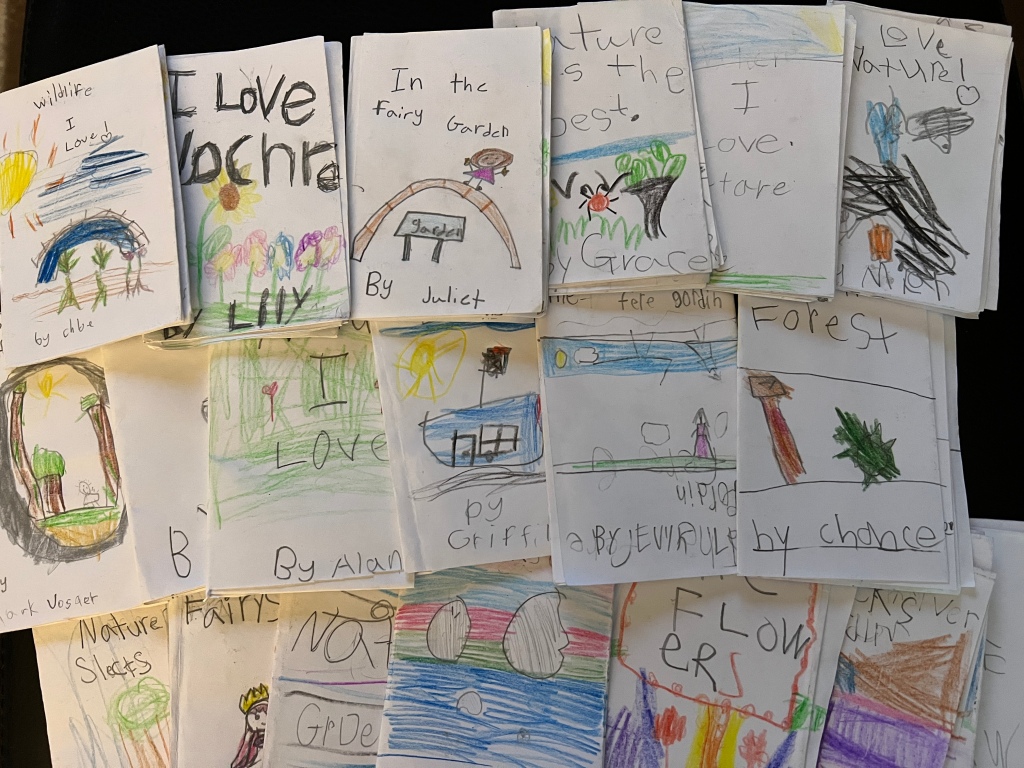
Monthly Archives: October 2022
The Magic of Mini-Zines
There’s something so special about making things. You use your own hands and something that was once a flat blank piece of paper is suddenly something else, something you created.
We’ve been making Zines in my first grade classroom. Our first attempt happened during our Dot Day celebration. We took a piece of printer paper, folded until we had 8 even rectangles, made a single cut…and voila! The paper became a small, multi-paged book. Those first books became our “A Dot Can Be…” zines.

Last week in honor of #writeout, we spent some time in our pollinator garden and basin area of the playground exploring nature’s artifacts. I wrote about our experience with our nature collectors and our wonder walk here. When I left off with that post students were in the process of creating zines about the nature items they collected. What I love most about these mini zines is the agency students feel about creating them. I also like that it allows students to both “write small” and to be literary in their approach. Students who are emerging as writers might create a page that reads, “Spiders Find a Way” with a beautiful drawing of a spider on a web, while more advanced writers can write, “A rock finds a way to scrub against the tree with happiness.” The writing and creating is accessible to everyone in our first grade class. And the zines are truly tiny jewels!

And after a conversation with some colleagues on the Connecting the Network Call with the National Writing Project last week, I took their suggestion and sent blank zines (made by my students) home with students with an invitation to explore on their own at home and to make a zine on their own. (We forgot to take them home on Friday, so they went home on Monday).
And…just like my colleagues suspected, my students were motivated to write at home. Today this lovely book came in:

My student was excited to read it to me…and for me to read it to the class! It was a delightful nature-based fictional story that involved a bug and a centipede. I’m guessing some more student-created zines may show up in the classroom later this week!
I know we’ll keep on making and writing…and making writing, both inside and outside the classroom. I’m excited about the writing community that my classroom is becoming.
#writeout: Because of an Acorn
When life gives you acorns…turn it into a #writeout inspiration!
On Saturday I found myself at UC Davis meeting with an incredible group of writing project teachers from all over the state as we launched year 2 of our CWP Environmental Literacy and Justice Collaborative. In that space we imagined all the ways to support our students as they learn about the earth and its systems, grow their appreciation of the natural world and resources we share, and use writing to think, to reflect, to question, and to advocate for the world we need and want for ourselves and for our future.
My colleague Carol brought some wonderful acorns she found in her neighborhood as inspiration for a making project…and lucky me, I ended up taking the extras home with me to use in my classroom. These acorns are bigger than the ones I am familiar with…and so beautiful!

And they were perfect for the book I had already borrowed from the library to read this week–Because of an Acorn by Lola Schaefer. After reading and studying this deceptively simple text, we talked about what they noticed in the book. They were quick to notice that it included aspects of life cycles…and they loved the cutouts on the first and last pages. Serendipitously the NWP Write Out newsletter included a link to a video about acorns by a park ranger at the Sequoia and Kings Canyon National Park. My students loved learning more about acorns–and the ways that trees communicate with each other.
Then it was time to pull out our #writeout pencils and notebooks. We took time to look carefully at the acorns and sketch them in detail. Students were encouraged to use numbers and words in addition to their sketch to capture information about their acorn.






After a break for their music class and recess, we returned to our notebooks for some writing. To push students’ thinking, we used the prompts: I noticed…, I wonder…, and It reminds me of to describe the acorn we had studied and sketched. These first graders had no hesitation. They had plenty to write about and were eager to get started! To keep the words flowing, students were encouraged to use their best “kid writing” (or phonetic spelling), prioritizing ideas over correctness.






Best of all, my students are paying attention to the environment and appreciating all that it has to offer. It is my goal that this immersion in nature will lead us toward advocacy as we consider the ways all of us, as community members–young and old(er), can be a catalyst for change to make the world a better place.
A Wonder Walk
First graders are naturally filled with wonder. It doesn’t take much to get them to look closely, to pay attention to details that many others miss.
Our school has the most amazing librarian. Last week I asked her about a book–a book I know I own, but cannot find in my classroom. And she not only found me a copy of that book, but she also suggested another that was new to me…and just what I needed today when I found it in my mailbox.
#writeout is a collaboration between the National Writing Project and the National Park Service that urges all of us to get outside and find inspiration in whatever nature is around us. We started #writeout yesterday with time in the school garden. Students learned about weeds, donned child-sized gardening gloves, and dug and pulled and delighted in seeing roots break free of the dry soil.
Today we read Wonder Walkers, that book our school librarian left in my mailbox. It was perfect for setting the stage for a wonder walk, time on our school grounds looking for interesting things (think leaves, seed pods, sticks, etc.) from nature that we collected using our collection tool (shout out to Little Pine Learners). Before we headed out we talked about what items we could collect and what we should not (living bugs, picking flowers and plants)–and students were excited to get started.
They looked carefully and their collectors began to fill. Some were exuberant and filled their spaces quickly, crowding dried roots and pine droppings with sticks and crunchy leaves. Others were more selective, leaving more spaces between the items collected. A child with sharp eyes found a dandelion puff that didn’t have to be picked, truly a treasure that her classmates envied!

Before we headed back into the classroom, I gathered students close and encouraged them to hold out the collectors so they could see each other’s collections and also so I could take a few pictures.

Once back in the classroom, students used their iPads to take a photo of their collector for future use. Then we settled to read another book. An old favorite, Weeds Find a Way by Cindy Jenson-Elliott, is a wonderful mentor text for students to use as a structure or frame for their writing. I loved the gasp when students realized that this book was non-fiction, yet so accessible with beautiful illustrations. They also remembered their experience with weeds from yesterday and the conversation with the garden teacher about how weeds are not “bad,” they are just not the plants you want in a particular space.
After comments and observations about the book, we tried on using the Weeds find a way… frame with objects from our collectors. “A red leaf finds a way to swish and swoosh through the air,” was one example that got us started.
We ended the day by starting a Zine to showcase our nature items through writing and drawing. We used a single sheet of copy paper to fold a small booklet (with a single cut and no tape or staples) that will soon become tiny treasures worthy of #writeout. More about that in another post!



